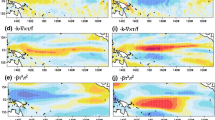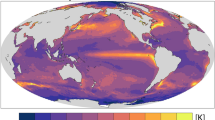Abstract
Nonlinear interdecadal changes in the El Niño-Southern Oscillation (ENSO) phenomenon are investigated using several tools: a nonlinear canonical correlation analysis (NLCCA) method based on neural networks, a hybrid coupled model, and the delayed oscillator theory. The leading NLCCA mode between the tropical Pacific wind stress (WS) and sea surface temperature (SST) reveals notable interdecadal changes of ENSO behaviour before and after the mid 1970s climate regime shift, with greater nonlinearity found during 1981–99 than during 1961–75. Spatial asymmetry (for both SST and WS anomalies) between warm El Niño and cool La Niña events was significantly enhanced in the later period. During 1981–99, the location of the equatorial easterly anomalies was unchanged from the earlier period, but in the opposite ENSO phase, the westerly anomalies were shifted eastward by up to 25°. According to the delayed oscillator theory, such an eastward shift would lengthen the duration of the warm events by up to 45%, but leave the duration of the cool events unchanged. Supporting evidence was found from a hybrid coupled model built with the Lamont dynamical ocean model coupled to a statistical atmospheric model consisting of either the leading NLCCA or CCA mode.






Similar content being viewed by others
References
An S-I, Wang B (2000) Interdecadal changes of the structure of the ENSO mode and its impact on the ENSO frequency. J Clim 13: 2044–2055
Balmaseda MA, Davet K, Anderson DLT (1995) Decadal and seasonal dependence of ENSO prediction skill. J Clim 8: 2705–2715
Barnett TP, Preisendorfer R (1987) Origins and levels of monthly and seasonal forecast skill for United States surface air temperatures determined by canonical correlation analysis. Mon Weather Rev 115: 1825–1850
Barnett TP, Pierce DW, Latif M, Dommenget D (1999) Interdecadal interactions between the tropics and midlatitudes in the Pacific basin. Geophys Res Lett 26: 615–618
Bretherton CS, Smith C, Wallace JM (1992) An intercomparison of methods for finding coupled patterns in climate data. J Clim 5: 541–560
Gu D, Philander SGH (1995) Secular changes of annual and interannual variability in the tropics during the past century. J Clim 8: 864–876
Gu D, Philander SGH (1997) Interdecadal climate fluctuations that depend on exchanges between the tropics and extratropics. Science 275: 805–807
Hsieh WW, Tang B (1998) Applying neural network models to prediction and data analysis in meteorology and oceanography. Bull Am Meteorol Soc 79: 1855–1870
Hsieh WW (2000) Nonlinear canonical correlation analysis by neural networks. Neural Networks 13: 1095–1105
Hsieh WW (2001) Nonlinear canonical correlation analysis of the tropical Pacific climate variability using a neural network approach. J Clim 14: 2528–2539
Jin FF (1997) An equatorial ocean recharge paradigm for ENSO, Part 1: conceptual model. J Atmos Sci 54: 811–829
Kirtman BP, Schopf PS (1998) Decadal variability in ENSO predictability and prediction. J Clim 11: 2804–2822
Kleeman R, McCreary JP, Klinger BA (1999) A mechanism for generating ENSO decadal variability. Geophys Res Lett 26: 1743–1746
Latif M, Kleeman R, Eckert C (1997) Greenhouse warming, decadal variability, or El Niño? An attempt to understand the anomalous 1990s. J Clim 10: 2221–2239
Pierce DW, Barnett TP, Latif M (2000) Connections between the Pacific ocean tropics and midlatitudes on decadal time scales. J Clim 13: 1173–1194
Rasmusson EM, Carpenter TH (1982) Variations in tropical sea surface temperature and surface wind fields associated with the Southern Oscillation El Niño. Mon Weather Rev 110: 354–384
Shriver JF, O’Brien JJ (1995) Low frequency variability of the equatorial Pacific ocean using a new pseudostress dataset: 1930–1989. J Clim 8: 2762–2786
Suarez MJ, Schopf PS (1988) A delayed oscillator for ENSO. J Atmos Sci 45: 3283–3287
Smith TM, Reynolds RW, Livezey RE, Stokes DC (1996) Reconstruction of historical sea surface temperatures using empirical orthogonal functions. J Clim 9: 1403–1420
Trenberth KE (1990) Recent observed interdecadal climate changes in the Northern Hemisphere. Bull Am Meteorol Soc 71: 988–993
Trenberth KE, Hurrell JW (1994) Decadal atmosphere–ocean variations in the Pacific. Clim Dyn 9: 303–319
von Storch H, Zwiers FW (1999) Statistical analysis in climate research. Cambridge University Cambridge, Press pp 484
Wallace JM, Rasmusson EM, Mitchell T, Kousky V, Sarachik E, von Storch H (1998) On the structure and evolution of ENSO-related climate variability in the tropical Pacific: lessons. J Geophys Res 103: 14,241–14,259
Wang B (1995) Interdecadal changes in El Niño onset in the last four decades. J Clim 8: 267–285
Wang B, Wang Y (1996) Temporal structure of the Southern Oscillation as revealed by waveform and wavelet analysis. J Clim 9: 1586–1598
Wang B, An S-I (2001) Why the properties of El Niño changed during the late 1970s. Geophys Res Lett 28: 3709–3712
Wang B, An S-I (2002) A mechanism for decadal changes of ENSO behavior: roles of background wind changes. Clim Dyn 18: 475–486
Weisberg RH, Wang C (1997) A western Pacific oscillator paradigm for the El Niño-Southern Oscillation. Geophy Res Lett 24: 779–782
Wu A, Hsieh WW (2002) Nonlinear canonical correlation analysis of the tropical Pacific wind stress and sea surface temperature. Clim Dyn 19: 713–722
Wu A, Hsieh WW, Zwiers FW (2003) Nonlinear modes of North American winter climate variability derived from a general circulation model simulation. J Clim 16: 2325–2339
Zhang R-H, Rothstein LM, Busalacchi AJ (1998) Origin of upper ocean warming and El Niño change on decadal scales in the tropical Pacific Ocean. Nature 391: 879–883
Zebiak SE, Cane MA (1987) A model El Niño-Southern Oscillation. Mon Weather Rev 115: 2262–2278
Acknowledgements.
W. Hsieh would like to thank Dr. Soon-Il An for helpful discussion. The ocean model used came from the Lamont coupled model, developed by Drs. S.E. Zebiak and M.A. Cane. W. Hsieh was supported by research and strategic grants from the Natural Sciences and Engineering Research Council of Canada, and by a grant from the Canadian Foundation for Climate and Atmospheric Sciences.
Author information
Authors and Affiliations
Corresponding author
Appendix 1: Cross-validation for the NLCCA model
Appendix 1: Cross-validation for the NLCCA model
Once the weight parameters (in the NN of Fig. 1) have been determined, an NLCCA model is built, the standard deviation std(u) and std(v) are known, and 〈u〉 = 〈v〉 = 0. If new x data become available, then u can be calculated, and v estimated by u · std(v)/std(u), which can then be used to predict y. Similarly, x can be predicted using new y data.
For cross validation, we divided the data for 1961–75 period into three segments of equal length (5 years). Three NLCCA models were to be built. The first was built without the data of the 1st segment, which was to be used as independent validation (or testing) data. Similarly, the 2nd and the 3rd models had the 2nd and 3rd segment of data left out for independent validation, respectively. Independent predictions by the three models were then collected to form a data time series of the whole period from 1961 to 1975, which was then compared with the observed data to alleviate the prediction skill. Same procedures were done on the data for 1981–99. Here we simply focus on the predictions of zero lead time, i.e., predict the WS using the simultaneous SST as predictor, and predict the SST using the simultaneous WS as predictor. Also only the NLCCA or CCA mode 1 is used here.
1.1 A.1 For the WS
Figure 7 shows the time evolution of the zonal WS anomalies along the equator (averaged within 5°S–5°N) predicted by the NLCCA models, where the westerly (easterly) anomalies associated with major El Niño (La Niña) events during the past four decades are successfully reproduced. It is notable that the zonal WS anomalies, especially the westerly anomalies, are intensified during the 1981–99 period. In Fig. 7b, an eastward displacement between the westerly (positive) anomalies and easterly (negative) anomalies can still be seen, although the displacement is much smaller than that shown in Fig. 4f, h. In contrast, there is basically no displacement between the westerly and easterly anomalies in the predictions for 1961–75 (Fig. 7a).
Time evolution of the equatorial zonal WS anomalies (averaged between 5°S and 5°N) predicted by the NLCCA models (only mode 1) using SST as predictor. Solid curves denote positive contours, dashed curves, negative contours, and thick curves, zero contours. The contour interval is 5 m2/s2. Areas with values greater than 10 are shaded, a and b represent the 1961–75 and 1981–99 period, respectively
Geographical distributions of the prediction skill for the zonal and meridional WS anomalies by the NLCCA models are shown in Fig. 8. For the zonal WS, the higher correlation is located over the central-western equatorial Pacific, and the NLCCA models have higher correlation skill in 1981–99 than in 1961–75 (Fig. 8a, b). Also shown in Fig. 8 are the difference between the skill of NLCCA models and the corresponding CCA models (NLCCA minus CCA), where significant improvement of the correlation (0.3–0.4) occurs in 1981–99 over the central-eastern Pacific and the western Pacific (Fig. 8d), while there is little improvement for 1961–75 (Fig. 8c). For the meridional WS, higher NLCCA skill relative to the CCA skill also occurs in the 1981–99 period over the central equatorial Pacific (Fig. 8h), versus insignificant improvement in the 1961–75 period (Fig. 8g). Similar conclusions are reached when examining the root mean square error (RMSE) (not shown).
Distributions of the correlation skill of the WS anomalies predicted by the NLCCA models relative to the observations (a, b, e, f) and the difference between the skill of NLCCA models and that of the corresponding CCA models (NLCCA minus CCA, c, d, g, h). The four panels in the left column represent the period 1961–75, and the right column, the period 1981–99. The upper four panels represent the zonal component, and the lower four panels, the meridional component. The contour interval is 0.1 with positive skill difference shaded
That the NLCCA models exhibit more advantage over the CCA models during the 1981–99 period than during the 1961–75 period indicates that the ENSO mode is more nonlinear after 1980, confirming the results described in Sect. 3.
1.2 A.2 For the SST
Figure 9 shows the time evolution of the equatorial SST anomalies (averaged within 5°S–5°N) predicted by the NLCCA models. Compared to the observations, despite the relative weak amplitudes, the SST anomalies during the past four decades are well predicted even with one NLCCA mode. The asymmetry between El Niño and La Niña, i.e., the eastward shift between the warming and the cooling is also successfully reproduced. This shift is more significant during 1981–99 (Fig. 9b) than during 1961–75 (Fig. 9a), suggesting again that there is more nonlinearity in the ENSO mode after 1980.
Time evolution of the equatorial SST anomalies (averaged between 5°S and 5°N) predicted by the NLCCA models (only mode 1) using WS as predictor. Solid curves denote positive contours, dashed curves, negative contours, and thick curves, zero contours. The contour interval is 0.5 °C with values greater than +1.0 °C shaded, a and b represent the 1961–75 and 1981–99 period, respectively
Table 4 lists the correlations and RMSE between the observed and predicted SST anomalies averaged over Niño12 (90°W–80°W, 10°S–0°), Niño3 (150°W–90°W, 5°S–5°N), Niño3.4 (170°W–120°W, 5°S–5°N) and Niño4 (160°E–150°W, 5°S–5°N) areas. During the period 1961–75, the NLCCA and CCA models have comparable prediction skills over all four areas. During 1981–99, despite similar skills over the Niño3.4 and Niño3 areas, significant improvement of prediction skills between the NLCCA and CCA models is achieved over the Niño4 and Niño12 areas. Note that, during 1981–99, the Niño12 area is where strong warming occurred (Fig. 4g), and the Niño4 area, where strong cooling occurred (Fig. 4e). SST anomalies over these two areas cannot be well described by the CCA model. It is natural that the NLCCA models give better prediction skills over these two areas.
Rights and permissions
About this article
Cite this article
Wu, A., Hsieh, W.W. Nonlinear interdecadal changes of the El Niño-Southern Oscillation. Climate Dynamics 21, 719–730 (2003). https://doi.org/10.1007/s00382-003-0361-1
Received:
Accepted:
Published:
Issue Date:
DOI: https://doi.org/10.1007/s00382-003-0361-1







